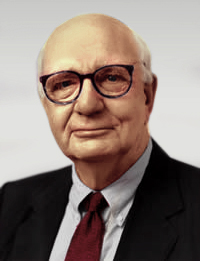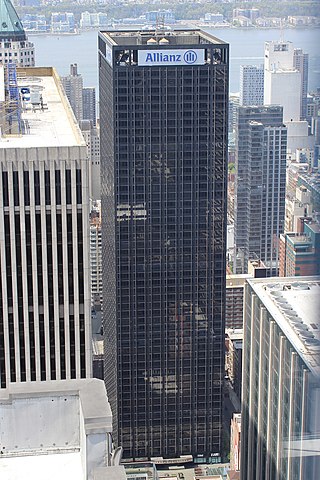Algorithmic trading is a method of executing orders using automated pre-programmed trading instructions accounting for variables such as time, price, and volume. This type of trading attempts to leverage the speed and computational resources of computers relative to human traders. In the twenty-first century, algorithmic trading has been gaining traction with both retail and institutional traders. A study in 2019 showed that around 92% of trading in the Forex market was performed by trading algorithms rather than humans.
A trader is a person, firm, or entity in finance who buys and sells financial instruments, such as forex, cryptocurrencies, stocks, bonds, commodities, derivatives, and mutual funds in the capacity of agent, hedger, arbitrager, or speculator.
In finance, a dark pool is a private forum for trading securities, derivatives, and other financial instruments. Liquidity on these markets is called dark pool liquidity. The bulk of dark pool trades represent large trades by financial institutions that are offered away from public exchanges like the New York Stock Exchange and the NASDAQ, so that such trades remain confidential and outside the purview of the general investing public. The fragmentation of electronic trading platforms has allowed dark pools to be created, and they are normally accessed through crossing networks or directly among market participants via private contractual arrangements. Generally, dark pools are not available to the public, but in some cases, they may be accessed indirectly by retail investors and traders via retail brokers.

Kenneth D. Pasternak is an American financial executive and entrepreneur. He is a co-founder along with Walter Raquet of Knight Trading Group, and also served as its chairman and CEO.
High-frequency trading (HFT) is a type of algorithmic trading in finance characterized by high speeds, high turnover rates, and high order-to-trade ratios that leverages high-frequency financial data and electronic trading tools. While there is no single definition of HFT, among its key attributes are highly sophisticated algorithms, co-location, and very short-term investment horizons in trading securities. HFT uses proprietary trading strategies carried out by computers to move in and out of positions in seconds or fractions of a second.

The Knight Capital Group was an American global financial services firm engaging in market making, electronic execution, and institutional sales and trading. With its high-frequency trading algorithms Knight was the largest trader in U.S. equities, with a market share of 17.3% on NYSE and 16.9% on NASDAQ. The company agreed to be acquired by Getco LLC in December 2012 after an August 2012 trading error lost $460 million. The merger was completed in July 2013, forming KCG Holdings.

The Volcker Rule is section 619 of the Dodd–Frank Wall Street Reform and Consumer Protection Act. The rule was originally proposed by American economist and former United States Federal Reserve Chairman Paul Volcker in 2010 to restrict United States banks from making certain kinds of speculative investments that do not benefit their customers. It was not implemented until July 2015. Volcker argued that such speculative activity played a key role in the 2007–2008 financial crisis. The rule is often referred to as a ban on proprietary trading by commercial banks, whereby deposits are used to trade on the bank's own accounts, although a number of exceptions to this ban were included in the Dodd–Frank law.
Scott Patterson is an American financial journalist and bestselling author. He is a staff reporter at The Wall Street Journal and author of Dark Pools: High-Speed Traders, A.I. Bandits, and the Threat to the Global Financial System and The New York Times bestselling bookThe Quants.

The Quants is the debut New York Times best selling book by Wall Street journalist Scott Patterson. It was released on February 2, 2010 by Crown Business. The book describes the world of quantitative analysis and the various hedge funds that use the technique. Two years later, Patterson published a follow-up book, Dark Pools: High Speed Traders, AI Bandits and the Threat to the Global Financial System, an investigative journey into the history of high-frequency trading and the spread of artificial intelligence in today’s markets.
Tradebot Systems, Inc. is a high-frequency equity trading firm in the US. Based in Kansas City, Missouri, they regularly account for 5% of the total trading volume in the US stock market. According to the founder, Dave Cummings, as of 2008, the firm "typically held stocks for 11 seconds", and "had not had a losing day in 4 years". That streak continued uninterrupted until 2017.

The Global Electronic Trading Company (GETCO), or Getco LLC, is an American proprietary algorithmic trading and electronic market making firm based in Chicago, Illinois. In December 2012, the firm agreed to acquire Knight Capital Group; this merger was completed in July 2013, forming the new company KCG Holdings.

Virtu Financial is an American company that provides financial services, trading products and market making services. Virtu provides product suite including offerings in execution, liquidity sourcing, analytics, broker-neutral, multi-dealer platforms in workflow technology and two-sided quotations and trades in equities, commodities, currencies, options, fixed income, and other securities on over 230 exchanges, markets, and dark pools. Virtu uses proprietary technology to trade large volumes of securities. The company went public on the Nasdaq in 2015.

Marc Chaikin is a stock analyst and Founder and CEO of Chaikin Analytics, LLC. He’s also the founder of Bomar Securities LP, which was sold to Instinet Corp. in 1992. He then went on to become Senior Vice President and Director at Instinet when it was owned by Reuters.com.

KCG Holdings, Inc. was an American global financial services firm engaging in market making, high-frequency trading, electronic execution, and institutional sales and trading. The company was formed on July 1, 2013, upon the completion of the merger between Knight Capital Group, Inc. and GETCO Holding Company, LLC. Global growth equity firm General Atlantic, who had a 25% stake in GETCO, made an additional equity investment at the time of the merger. Rene Kern, managing director at General Atlantic joined the board of directors

The Speed Traders, An Insider's Look at the New High-Frequency Trading Phenomenon That is Transforming the Investing World (ISBN 978-0-07-176828-3) is a book on high-frequency trading, authored by Edgar Perez. It examines the 2010 Flash Crash incident that led to a significant decline in the value of U.S. stocks on May 6, 2010.

Flash Boys: A Wall Street Revolt is a book by the American writer Michael Lewis, published by W. W. Norton & Company on March 31, 2014. The book is a non-fiction investigation into the phenomenon of high-frequency trading (HFT) in the US financial market, with the author interviewing and collecting the experiences of several individuals working on Wall Street. Lewis concludes that HFT is used as a method to front run orders placed by investors. He goes further to suggest that broad technological changes and unethical trading practices have transformed the U.S. stock market from "the world's most public, most democratic, financial market" into a "rigged" market.
Bradley Toshio Katsuyama is a Canadian financial services executive. He is the CEO and co-founder of the IEX, the Investors Exchange. He left RBC in 2012 to co-found IEX under the premise that it would be a fairer stock trading venue than other exchanges.

Interactive Brokers, Inc. (IB), headquartered in Greenwich, Connecticut, is an American multinational brokerage firm which operates the largest electronic trading platform in the United States by number of daily average revenue trades. In 2023, the platform processed an average of 3 million trades per trading day. Interactive Brokers is the largest foreign exchange market broker and is one of the largest prime brokers servicing commodity brokers. The company brokers stocks, options, futures contracts, exchange of futures for physicals, options on futures, bonds, mutual funds, currency, cryptocurrency, contracts for difference, derivatives, and event-based trading contracts on election and other outcomes. Interactive Brokers offers direct market access, omnibus and non-disclosed broker accounts, and provides clearing services. The firm has operations in 34 countries and 27 currencies and has 2.6 million institutional and individual brokerage customers, with total customer equity of US$426 billion as of December 31, 2023. In addition to its headquarters in Greenwich, on the Gold Coast of Connecticut, the company has offices in major financial centers worldwide. More than half of the company's customers reside outside the United States, in approximately 200 countries.

Hudson River Trading is a quantitative trading firm headquartered in New York City and founded in 2002. In 2014, it accounted for about 5% of all trading in the United States. Hudson River Trading employs over 800 people in offices around the world, including New York, Chicago, Austin, Boulder, London, Singapore, Shanghai, Mumbai and Dublin. The firm focuses on research and development of automated trading algorithms using mathematical techniques, and trades on over 100 markets worldwide.
Radix Trading is an American proprietary trading firm headquartered in Chicago. It has additional offices in New York and Amsterdam.












